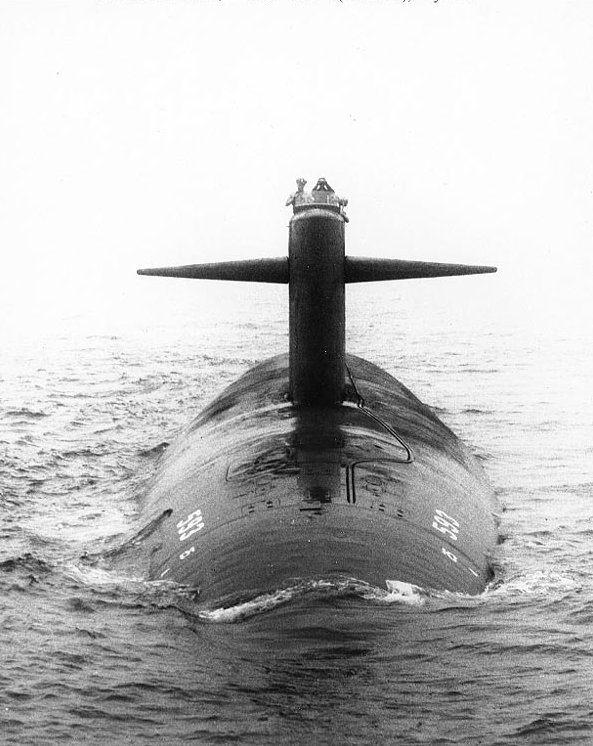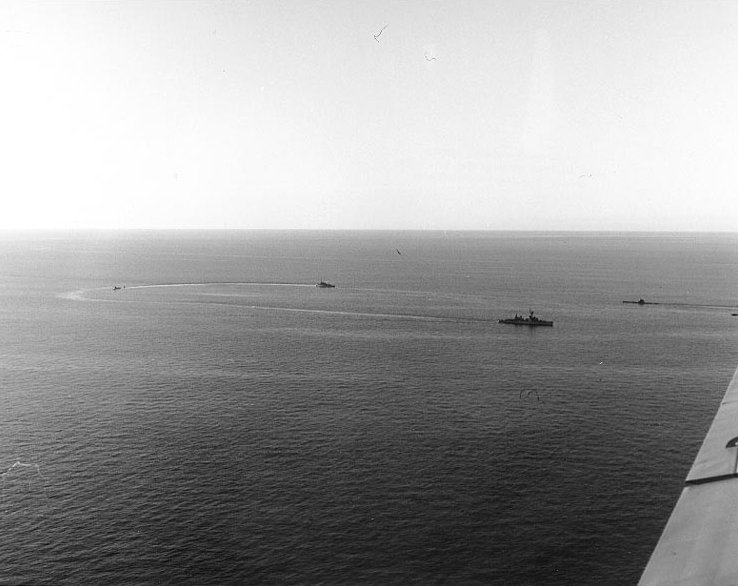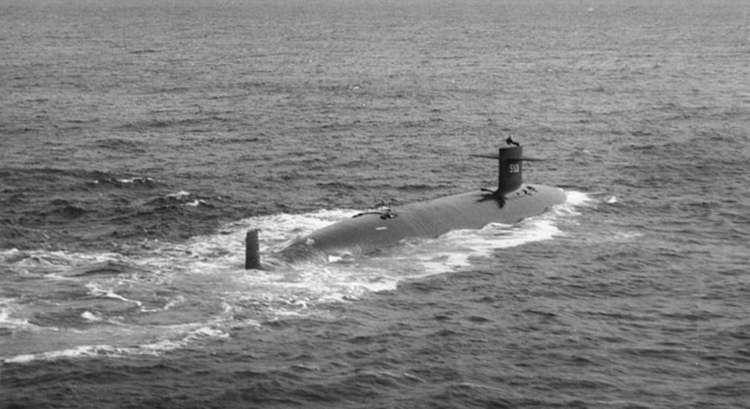Over an hour into the test depth trial, the submarine rescue ship USS Skylark’s commanding officer received yet another garbling message from the USS Thresher, barely making out the words: “a ship breaking up . . . like a compartment collapsing.“
Advertisement
Unknowingly, it would be among the last time the world would hear about the atomic submarine, which sank deep into the Atlantic Ocean more than 8,000 feet, and with it, its 129 crew on board—forever lost at sea.
The sinking of the Thresher sixty years ago remains one of the most significant tragedies in the history of the US Navy, with the loss of all its crew serving as a sobering reminder of the dangers inherent in submarine operations. But it wasn’t all in vain, leading to significant safety procedures and training changes. Today, the memory of the Thresher and its crew lives on as a statement of their bravery and sacrifice in service of their country.
USS Thresher: First of Its Kind
The lead vessel, the first of its kind, the USS Thresher (SSN-593), is a nuclear-powered submarine developed by Portsmouth Naval Shipyard in the 1950s and early 1960s with a design that combines the attributes of an “attack” and a specialized “hunter-killer” underwater craft. The US Navy initiated the program amid the Cold War era in response to the Soviet Union’s development of advanced submarine technology, which posed a significant threat to American naval dominance.
Built to be faster and more maneuverable, the Thresher-class ship sought to become the service’s more advanced submarine than any that had come before it. She had a cigar-shaped hull, which derived its design from the research submarine Albacore (AGSS-569). Its high-strength HY-80 steel alloy made the underwater vessel unique compared to other subs before her, enabling its operators to reach greater depths and maximize underwater performance.
Moreover, the Thresher featured several more technological advances, including improved sonar and better control systems. It boasted a massive BQQ-2 sonar at its bow, an enhanced passive sonar system capable of detecting and tracking other vessels by listening for the sounds they produce with high accuracy.

According to US Naval Institute, the submarine’s four torpedo tubes were aft of the sonar, two on each side, angled out ten degrees from the centerline. Later, she underwent an overhaul fitted to fire the ASROC-antisubmarine rocket from those tubes. Moreover, its S5W reactor plant would give her unlimited range, and her pressure hull would enable her to dive to some 1,300 feet-unprecedented for a US submarine.
After successfully completing its initial sea trials, USS Thresher was commissioned into the Navy fleet on August 3, 1961, over a year after its launch from Portsmouth Naval Shipyard in New Hampshire. The submarine continued to undergo a series of tests and exercises off the Atlantic coast, sailing as far south as Puerto Rico under Commander Dean L. Axene. Following its shock test, the nuclear-powered sub returned to New Hampshire for major maintenance work. Axene was transferred to the newly constructed Polaris ballistic-missile submarine, USS John C. Calhoun (SSBN-630), during this period. Lieutenant Commander John Wesley Harvey assumed command of Thresher until that fateful day.
That Fateful Morning
After a nine-month-long overhaul, the Thresher finally returned to sea for another set of sea trials. As a first-of-its-kind submarine, the maintenance work of the sub took longer than expected.
Preparation for the post-overhaul sea trial began in the wee hours of April 9, 1963, with its engineers launching a four-hour countdown to start the Thresher’s reactor plant. By around 7:30 AM, the engine room was ready to set out on a deep-sea dive.
Throughout the deep-dive trial, the surface vessel USS Skylark (ASR-20), a Penguin-class rescue ship, accompanied the atomic submarine and maintained communication via an “underwater telephone” designated UQC. A crew of 129 men partook in the trial, including 12 officers and 96 enlisted men; a Submarine Force staff officer; Portsmouth yard’s three officers and 13 civilian employees; a specialist from the Naval Ordnance Laboratory; and three civilian factory representatives.
When all preparations were ready, the Thresher quickly cast off her lines and steamed southward from the yard, venturing into the vast open sea beyond Odiorenes Point and rendezvoused with the Skylark, with divers and specialized equipment carried on board, including a rescue chamber in case of emergency.

The Thresher made a shallow dive testing out the sub’s equipment before Harvey directed the Skylark to rendezvous with them some 200 miles east of Cape Cod for the submarine’s deep-water tests. Around the afternoon of April 9, the atomic submarine slipped beneath the waves and headed toward deeper water.
The following day, at 6:35 AM on April 10, the Thresher surfaced to periscope depth about ten miles from the Skylark. Just over an hour later, Harvey notified the rescue ship that he was taking the Thresher to its “test depth,” which was its maximum operating depth, typically noted as 1,300 feet. However, before its long overhaul period, the US Naval Institute reported that the sub had already reached its test depth around 40 times.
According to reports, the test-depth dive began around 7:47 AM, with the Thresher notifying Skylark via the UQC. Communication went steadily back and forth between the vessels, and by 8:09 AM, the sub had already reached about one-half of its test depth.
At 8:35, the Thresher reported “minus 300 feet” to Skylark and, nearly thirty minutes later, requested a repetition of a course reading. After ten more minutes, the two ships conducted a routine check and made a satisfactory underwater telephone call. However, seconds later, the atomic sub relayed a garbled communication, reporting: “Have position up angle. . . . Attempting to blow up.”
This message would become the last known transmission by the Thresher, but the recording of its exact time was not available. Though, around 9:17 AM, Skylark’s commanding officer, Lieutenant Commander Stanley W. Hecker, attested of hearing what sounded like “a ship breaking up . . . like a compartment collapsing” through the garbled message that ended with the distinct words “test depth,” narrated by the US Naval Institute.
Other attempted communications failed, including dropping grenades and a prearranged signal between a submarine and surface in case UQC communication failed.
It soon became apparent she had sunk some 8,400 feet deep, consequently taking all the lives on board.
Resigned Conclusion
Shortly after the communications failure, the US Navy launched an extensive search. During this period, they will recover debris from the submarine. Still, it wasn’t until the bathyscaph Trieste II participated in the hunt that the service finally confirmed the wreckage of the Thresher during a 1964 expedition, including a twisted pipe with the marking “593 Boat.”
While the exact cause of the sinking of the USS Thresher remains uncertain, the Court of Inquiry resigned to the conclusion, based on the collected evidence, that she probably sunk due to a leak in a silver-brazed joint in the engine room, which caused a piping failure, thus sparked a short circuit in critical electrical systems. The problem quickly spread, and the subsequent loss of power led to the sub’s inability to maneuver and eventually succumbing to a rapid descent toward crush depth.

The authorities estimated that the Thresher had a crush depth of around 2,400 feet, less than the depth it sank. Furthermore, the sub exceeded its crush depth, and the pressure of the surrounding water caused the hull to implode, resulting in the loss of the vessel and all 129 crew members.
Twenty-five years later, in 1988, Vice Admiral Bruce DeMars, the Navy’s chief submarine officer, said:
“The loss of Thresher initiated fundamental changes in how we do business—changes in design, construction, inspections, safety checks, tests, and more. We have not forgotten the lessons learned. It’s a much safer submarine force today.”
Nevertheless, the lives lost in the tragic sinking of the Thresher weren’t wasted in vain, as it led to significant changes in the Navy’s submarine program, including revisions in the design, construction, and safety procedures of underwater vessels.
—
Check out “The Death of the USS Thresher” by Norman Polmar for more in-depth reading behind the story of the US Navy’s deadliest submarine disaster!










COMMENTS
You must become a subscriber or login to view or post comments on this article.